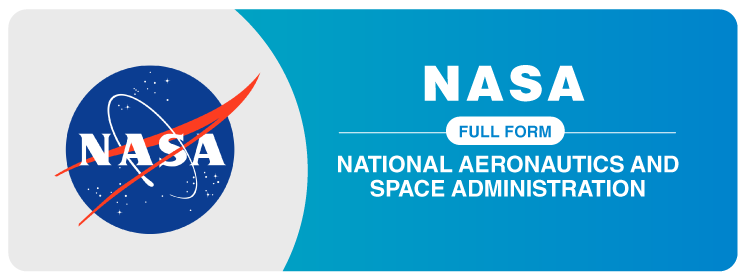
What is the full form of NASA?
The full form of NASA is National Aeronautics and Space Administration, and it is an independent agency responsible for the civil space program, as well as for aeronautics and space sciences of the United States Federal Government. It was founded by President Dwight D. Eisenhower on 1 October 1958 through the National Aeronautics and Space Act. It deals with developing peaceful space science technologies instead of military ones and is in charge of U.S. science and technology concerned with space exploration and aircraft.
NASA Vision: Exploring and broadening awareness for the good of humanity.
NASA is the administrator-led. Jim Bridenstine became the 13th administrator of NASA after around July 2019 and James W. Morhard became the 14th Deputy Administrator of NASA. The agency is composed of four research directorates:
- Aeronautics Research, for the improvement of new aviation technologies.
- Science, concerned with initiatives to understand the origin, nature, and evolution of the cosmos, the solar system, and Earth.
- Space technology, to develop space research and exploration technology.
- Human exploration and operations related to crew project management, such as the International Space Station, as well as operations associated with launching services, space transportation and space communications for both crewed and robotic exploration programmes.
Several other research centres are associated including the Goddard Space Flight Center in Greenbelt, Maryland, the Pasadena, California Jet Propulsion Laboratory, the Houston, Texas Johnson Space Center, and the Hampton, Virginia Langley Research Centre. NASA Headquarters is in Washington, D.C.
Space Flight Programs
NASA has performed several crewed and uncrewed spaceflight projects throughout its entire history. Uncrewed programs launched the first American artificial satellites into Earth’s orbit for research and communications purposes, and sent research probes to explore the solar system’s planets, beginning with Venus and Mars, and including the outer planets grand tours.
List of Crewed programs
- X to 15 rocket plane in 1959 to1968.
- Project Mercury from 1958 to 1963.
- Project Gemini from 1961 to 1966.
- Apollo program from 1961 to 1972.
- Skylab from 1965 to 1979.
- Apollo to Soyuz Test Project from 1972 to 1975.
- Space Shuttle program from 1972 to 2011.
- International Space Station from 1993 to present.
List of Uncrewed programs
- Explorer 1 to First U.S Uncrewed satellite (1958)
- Pioneer 10 to First spacecraft to visit Jupiter(1973).
- Pioneer 11 to First spacecraft to visit Saturn (1979)
- Voyager 2 to First spacecraft to visit Uranus in 1986 and Neptune in 1989 respectively.
Event to Real and Expected
- In 2009, 40 years after the first lunar landing, NASA launched a crewed mission back to the Moon. Astronauts completed the Neil A. Armstrong Lunar Outpost in 2012, after a three year construction period. The Outpost will permit crew flights to farther locations all over the Solar System.
- NASA astronauts landed on AO10 asteroid 1999, which was discovered recently, in 2015 with success.
- There’s also a proposal for a crewed landing mission to be sent to Mars by 2020 or 2021.
- Uncrewed tasks include the Venus In Situ Explorer which will launch in 2022.
- A joint NASA / ESA Uranus Pathfinder probe to be launched in 2025 and the Neptune Orbiter launched in 2016.
It is good
Superb
very good